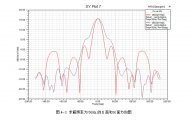超宽带双脊喇叭天线的设计

超宽带双脊喇叭天线的设计(论文9000字)
摘要:随着电磁波传播技术的不断进步与发展、现代企业生产规模的不断扩大和超宽带天线的广泛应用,天线的使用已经越来越广泛,因此现代大规模企业对于天线的制作提出了新的要求,性能更好、效率更高的天线更能受到人们的喜爱。基于上述研究背景,本文利用操作便捷、功能齐全的高频结构仿真软件HFSS,研究和优化得到超宽带双脊喇叭天线的仿真结果。设计目标为:1.频率范围为1-10GHz;2.带宽增益大于等于10dB;3.驻波小于等于2。经过HFSS仿真、优化得到的频率范围为1-10GHz的天线的带宽增益最小大约为10.6dB,最大大约为22dB,驻波最小为大约1.2,最小为大约1.8,符合设计的要求。今后的设计目标可以向频率范围更大、带宽增益更大、驻波更小的方向发展。
关键字:超宽带天线;喇叭天线;HFSS;优化设计
Design of ultra-wideband dual-ridge horn antenna
Abstract:With the continuous advancement and development of electromagnetic wave propagation technology, the continuous expansion of modern enterprise production scale and the wide application of ultra-wideband antennas, the use of antennas has become more and more extensive, so modern large-scale enterprises have put forward new requirements for the production of antennas. Antennas with better performance and higher efficiency are more popular. Based on the above research background, this thesis uses the high-frequency structure simulation software HFSS with convenient operation and complete functions to study and optimize the simulation results of the ultra-wideband dual-ridge horn antenna. The design goals are: 1. The frequency range is 1-10 GHz; 2. The bandwidth gain is greater than or equal to 10 dB; 3. The standing wave is less than or equal to 2. The HFSS simulation and optimization of the antenna with a frequency range of 1-10 GHz has a minimum bandwidth gain of about 10.6 dB, a maximum of about 22 dB, a minimum standing wave of about 1.2, and a minimum of about 1.8, which meets the design requirements. Future design goals can be developed in the direction of larger frequency ranges, greater bandwidth gains, and smaller standing waves.
Key words:Ultra-wideband antenna; Horn antenna; HFSS; optimized design
[资料来源:www.doc163.com]

目 录
1绪论 1
1.1课题背景 1
1.2国内外研究现状 1
1.2.1超宽带天线的发展历史 1
1.2.2超宽带天线的研究现状 2
1.3本文主要研究内容及结构 3
2超宽带双脊喇叭天线的基本理论 4
2.1天线的主要参数 4
2.1.1增益 4
2.1.2频率范围 4
2.1.3驻波比 4
2.1.4旁瓣电平 4
2.1.5方向图 4
2.2加脊喇叭天线的构成 5
2.3高频结构仿真软件HFSS的介绍 5
2.3.1软件的功能 5
2.3.2软件的设计环境 5
2.3.3软件的仿真流程 6 [版权所有:http://DOC163.com]
3超宽带双脊喇叭天线的研究与设计 7
3.1建立模型 7
3.1.1添加工程 7
3.1.2设置变量 7
3.1.3创建模型 7
3.1.4布尔操作 8
3.2设置工作环境 8
3.2.1边界条件 8
3.2.2端口激励 8
3.2.3辐射边界条件 9
3.2.4求解设置 9
3.3设计检查 9
3.4结构的优化 10
3.4.1喇叭口径面尺寸的优化 10
3.4.2喇叭深度的优化 10
3.5双脊的设计 10
3.5.1双脊的作用 10
3.5.2双脊的曲线方程 10
3.5.3双脊的建模 11
3.5.4双脊的馈电设置 12
3.5.5双脊参数的优化 12
3.6其他优化 12
3.7双脊喇叭模型图 13
4超宽带双脊喇叭天线的仿真结果 15
4.1驻波 15
4.2回波损耗S11 15
4.3方向图 16
4.4仿真结果汇总 20
5总结与展望 21
5.1总结 21
5.2展望 21
参考文献 22 [来源:http://www.doc163.com]
